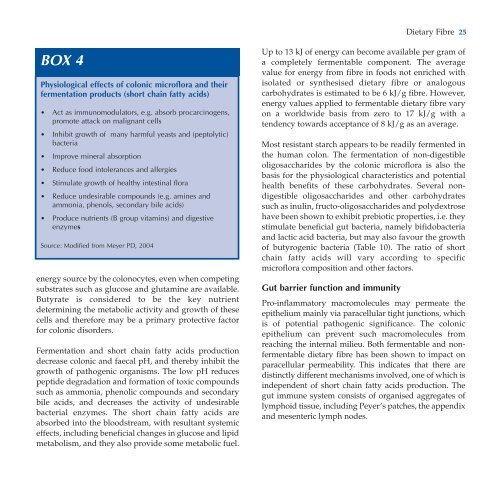Dietary Fibre - ILSI Argentina
Dietary Fibre - ILSI Argentina
Dietary Fibre - ILSI Argentina
You also want an ePaper? Increase the reach of your titles
YUMPU automatically turns print PDFs into web optimized ePapers that Google loves.
<strong>Dietary</strong> <strong>Fibre</strong> 25<br />
BOX 4<br />
Physiological effects of colonic microflora and their<br />
fermentation products (short chain fatty acids)<br />
• Act as immunomodulators, e.g. absorb procarcinogens,<br />
promote attack on malignant cells<br />
• Inhibit growth of many harmful yeasts and (peptolytic)<br />
bacteria<br />
• Improve mineral absorption<br />
• Reduce food intolerances and allergies<br />
• Stimulate growth of healthy intestinal flora<br />
• Reduce undesirable compounds (e.g. amines and<br />
ammonia, phenols, secondary bile acids)<br />
• Produce nutrients (B group vitamins) and digestive<br />
enzymes<br />
Source: Modified from Meyer PD, 2004<br />
energy source by the colonocytes, even when competing<br />
substrates such as glucose and glutamine are available.<br />
Butyrate is considered to be the key nutrient<br />
determining the metabolic activity and growth of these<br />
cells and therefore may be a primary protective factor<br />
for colonic disorders.<br />
Fermentation and short chain fatty acids production<br />
decrease colonic and faecal pH, and thereby inhibit the<br />
growth of pathogenic organisms. The low pH reduces<br />
peptide degradation and formation of toxic compounds<br />
such as ammonia, phenolic compounds and secondary<br />
bile acids, and decreases the activity of undesirable<br />
bacterial enzymes. The short chain fatty acids are<br />
absorbed into the bloodstream, with resultant systemic<br />
effects, including beneficial changes in glucose and lipid<br />
metabolism, and they also provide some metabolic fuel.<br />
Up to 13 kJ of energy can become available per gram of<br />
a completely fermentable component. The average<br />
value for energy from fibre in foods not enriched with<br />
isolated or synthesised dietary fibre or analogous<br />
carbohydrates is estimated to be 6 kJ/g fibre. However,<br />
energy values applied to fermentable dietary fibre vary<br />
on a worldwide basis from zero to 17 kJ/g with a<br />
tendency towards acceptance of 8 kJ/g as an average.<br />
Most resistant starch appears to be readily fermented in<br />
the human colon. The fermentation of non-digestible<br />
oligosaccharides by the colonic microflora is also the<br />
basis for the physiological characteristics and potential<br />
health benefits of these carbohydrates. Several nondigestible<br />
oligosaccharides and other carbohydrates<br />
such as inulin, fructo-oligosaccharides and polydextrose<br />
have been shown to exhibit prebiotic properties, i.e. they<br />
stimulate beneficial gut bacteria, namely bifidobacteria<br />
and lactic acid bacteria, but may also favour the growth<br />
of butyrogenic bacteria (Table 10). The ratio of short<br />
chain fatty acids will vary according to specific<br />
microflora composition and other factors.<br />
Gut barrier function and immunity<br />
Pro-inflammatory macromolecules may permeate the<br />
epithelium mainly via paracellular tight junctions, which<br />
is of potential pathogenic significance. The colonic<br />
epithelium can prevent such macromolecules from<br />
reaching the internal milieu. Both fermentable and nonfermentable<br />
dietary fibre has been shown to impact on<br />
paracellular permeability. This indicates that there are<br />
distinctly different mechanisms involved, one of which is<br />
independent of short chain fatty acids production. The<br />
gut immune system consists of organised aggregates of<br />
lymphoid tissue, including Peyer’s patches, the appendix<br />
and mesenteric lymph nodes.

















